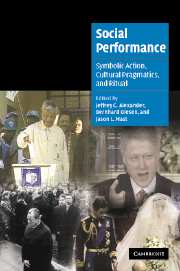Book contents
- Frontmatter
- Contents
- List of figures
- List of tables
- List of contributors
- Introduction: symbolic action in theory and practice: the cultural pragmatics of symbolic action
- 1 Cultural pragmatics: social performance between ritual and strategy
- 2 From the depths of despair: performance, counterperformance, and “September 11”
- 3 The cultural pragmatics of event-ness: the Clinton / Lewinsky affair
- 4 Social dramas, shipwrecks, and cockfights: conflict and complicity in social performance
- 5 Performing a “new” nation: the role of the TRC in South Africa
- 6 Performing opposition or, how social movements move
- 7 Politics as theatre: an alternative view of the rationalities of power
- 8 Symbols in action: Willy Brandt's kneefall at the Warsaw Memorial
- 9 The promise of performance and the problem of order
- 10 Performance art
- 11 Performing the sacred: a Durkheimian perspective on the performative turn in the social sciences
- Index
- Cambridge Cultural Social Studies
- References
8 - Symbols in action: Willy Brandt's kneefall at the Warsaw Memorial
Published online by Cambridge University Press: 07 December 2009
- Frontmatter
- Contents
- List of figures
- List of tables
- List of contributors
- Introduction: symbolic action in theory and practice: the cultural pragmatics of symbolic action
- 1 Cultural pragmatics: social performance between ritual and strategy
- 2 From the depths of despair: performance, counterperformance, and “September 11”
- 3 The cultural pragmatics of event-ness: the Clinton / Lewinsky affair
- 4 Social dramas, shipwrecks, and cockfights: conflict and complicity in social performance
- 5 Performing a “new” nation: the role of the TRC in South Africa
- 6 Performing opposition or, how social movements move
- 7 Politics as theatre: an alternative view of the rationalities of power
- 8 Symbols in action: Willy Brandt's kneefall at the Warsaw Memorial
- 9 The promise of performance and the problem of order
- 10 Performance art
- 11 Performing the sacred: a Durkheimian perspective on the performative turn in the social sciences
- Index
- Cambridge Cultural Social Studies
- References
Summary
“Through all former and later pictures, [… I] see a kneeling man in Warsaw. […] there are people who can say more with their back than others with thousand words. It was obvious that every part of this body felt something that wanted to be expressed – about guilt, penance and an infinite pain.”
Cees NooteboomIntroduction
On December 7, 1970, Willy Brandt, the Chancellor of the German Federal Republic, was to sign the Warsaw Treaty, one of the treaties between Germany and Warsaw Pact nations currently seen as the first diplomatic step to the breakthrough of the Iron Curtain. The official signing took place in Warsaw and, as expected in the international political arena, it was paralleled by several commemorative ceremonies. The agenda included a visit to the Warsaw Memorial, erected in honor of the Jewish heroes of the 1943 Ghetto Uprising. Surrounded by the official political entourage and several representatives of the international press, Mr. Brandt stepped out of his vehicle, slowly approached the Memorial, straightened out the ribbon of a previously laid flower wreath and took a step back. Then something unexpected happened: he suddenly sank on to his knees in front of the Memorial and remained still for a minute. The next day, the response to his gesture was enormous. The picture of Brandt kneeling made its mark in the international press. All major newspapers in Europe and the United States enthusiastically featured this “emotional moment” in international relations.
- Type
- Chapter
- Information
- Social PerformanceSymbolic Action, Cultural Pragmatics, and Ritual, pp. 257 - 282Publisher: Cambridge University PressPrint publication year: 2006
References
- 28
- Cited by

